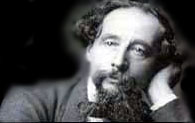

Few names in literature are as well-known or as well-respected as that of Charles Dickens. His life spread through the reign of four English monarchs, and he was a contemporary of authors such as Mark Twain and Charlotte Bronte. Dickens authored fifteen major novels and several short stories that touched on various topics of the social life of England during his lifetime, and the inspiration for these came from his life and experience. With these factors as his motivation, Dickens became one of the best known writers of all time.
Born on February 7th, 1812, the son of John and Elizabeth Dickens, he experienced the happiest part of his childhood before the age of 12. While he was 12 years old, his father was placed in prison for outstanding debts. Charles, being the oldest male in the house, was forced into the role of head of the house. This forced him to quit school, and take up work at a boot-blacking factory to help support the family. Charles despised this job, and this became one of the experiences in his life that would in the future fuel his writings. His father was released after three months, and Charles attended school once again.
In 1827, Charles was taken from school, and he went into service for an attorney as an office boy. At this point in his life, Charles decided he wanted to become a journalist. He worked as a free-lance journalist, and in 1833, he published his first work, “Dinner at Poplar Walk.” In the meantime, he discovered the love of several women. Dickens's love life is an adventure of its own, but it ended when he married Catherine Hogarth in 1836. Around this point in time, the Dickens known to everyone, that being Dickens the writer, emerged. He became so famous in America, that hundreds, sometimes thousands, of people would gather to wait for the sea-going ship carrying his latest work to arrive. This was not unlike the lines formed around bookstores when the latest Harry Potter story is due to be released.
Throughout his career, Dickens addressed various issues in his novels. There are several examples. He addressed the Poor Law Amendment Act of 1834 (Oliver Twist, 1837-39); the French Revolution (Tale of Two Cities, 1859); inner workings of courts (Bleak House, 1852-53); and social reform (Hard Times, 1854). He also wrote a book thought to be somewhat autobiographical (David Copperfield, 1849-50). His best known work is the first and best of the Christmas books he wrote, that being A Christmas Carol, written in 1843.
In his later years, he embarked on several public reading tours, throughout Britain and America. He began to suffer from bad health around this time, due to overworking himself between constant writing and touring. Doctors urged him to stop this behavior in hopes that he would regain his good health, but he refused to listen to them. On June 8th, 1870, Dickens suffered a stroke. He died on the following day, leaving one unfinished work, Mystery of Edwin Drood (1870). Dickens was buried at Westminster Abbey on June 14th, and this is the inscription left on his tombstone: "He was a sympathiser to the poor, the suffering, and the oppressed; and by his death, one of England's greatest writers is lost to the world."